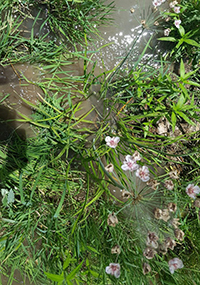Flowering rush
Butomus umbellatus
Keys to Identification
- The leaves are triangular
- Flowers are three-petaled with three same colored sepals below
Family
Butomaceae – Flowering rush family
USDA Code
BUUM
Legal Status
Colorado Noxious Weed List A
Identification
Lifecycle
Perennial aquatic
Growth form
Resembles rushes. Grows erect in semi-submerged areas and leaves float on the surface of deeper water.
Flower
Flowers are pink to white, 1 inch wide, 3 petals with 3 petal-like sepals, 20-50 in umbrella-shaped clusters
Flowers July-September
Seeds/Fruit
Fruit deep brown, about ½ inch long, filled with tiny seeds. At maturity the fruit splits to release the seed. Most seed is not viable
Leaves
Emergent leaves basal, sword-like, to 3 ½ feet long and ½ inch wide, triangular, curved at the end. Submersed leaves limp
Stems
Plants are up to 5 feet tall
Stems erect and triangular
Roots
Thick creeping rhizomes have bulblets that can easily break off and form new plants
Impacts
Ecological
Displaces native plants. May form thick monocultures and may interfere with access to water
Human
May interfere with recreational access to water bodies
Habitat and Distribution
General requirements
An escaped ornamental. Found in lakes, ponds, and slow-moving water
Distribution
A few plants were found in Mesa County in 2018
Historical
Native to Europe and Asia
Biology/Ecology
Mode of reproduction
Reproduces by bulblets, rhizomes and vegetatively
Other
Not a true rush, it is the only genus in the Butomaceae family
Muskrats use pieces of the plant to build their homes and may contribute to the spread
Photo by: Leslie J. Mehrhoff, University of Connecticut, Bugwood.org

Photo by: Leslie J. Mehrhoff, University of Connecticut, Bugwood.org

